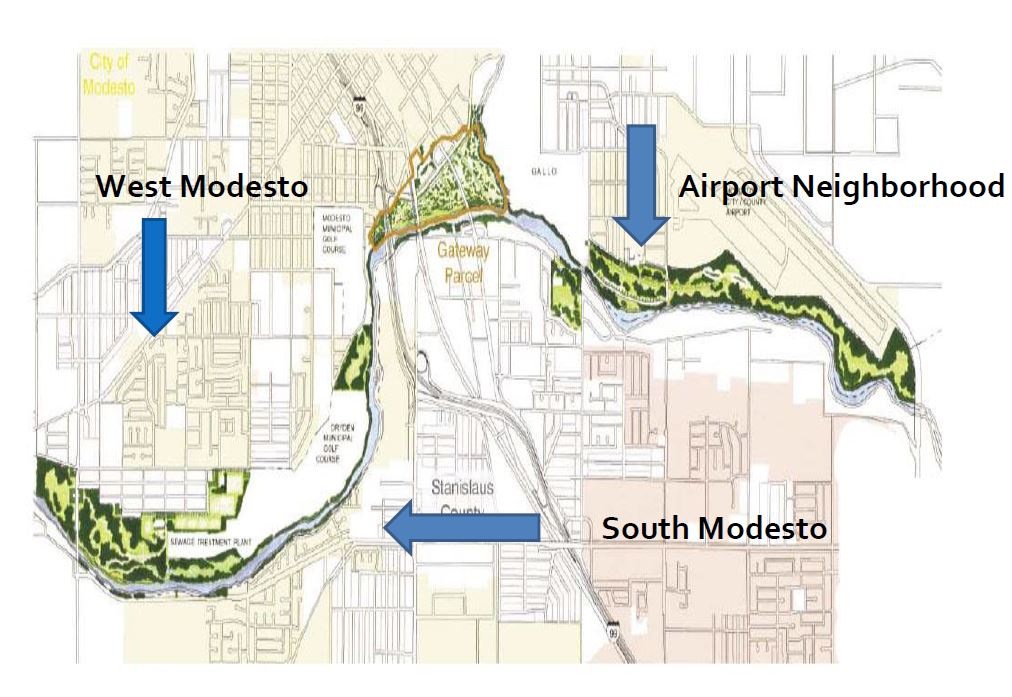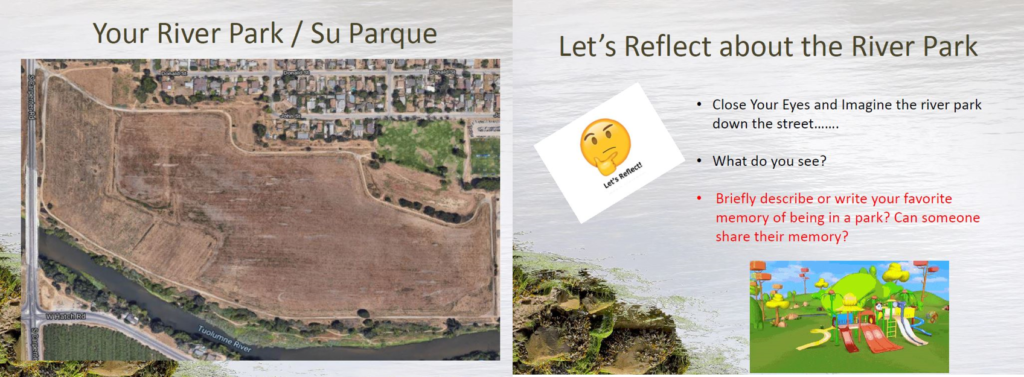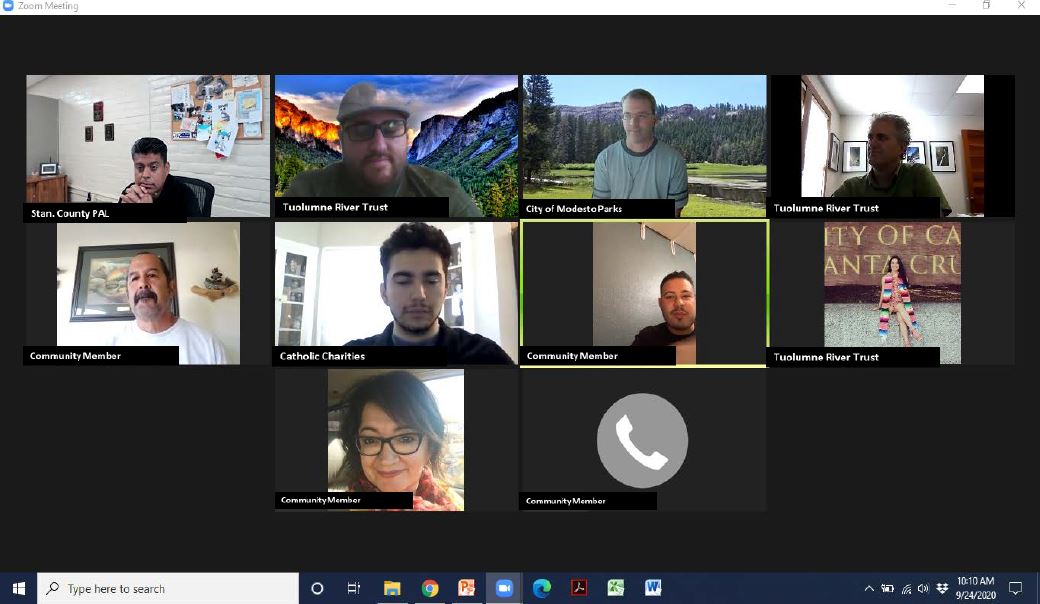Water Foundation (WF): Thanks for chatting with us, Edgar. Can you share how you got into this type of work?
Edgar Garibay (EG): Prior to working at the Tuolumne River Trust, I worked a little over two years at Catholic Charities in their environmental justice program. That’s how I began doing regional land use planning and advocacy for Stanislaus County, working with statewide networks, and working with the faith community and the community in general.
WF: What are you working on in Modesto?
EG: We work with community residents in West and South Modesto and stakeholders to advocate for the development of the Tuolumne River Regional Park — Carpenter Road Park (TRRP). The TRRP covers a 7-mile-long continuous area, but there are still some parts that need to be developed, including the project we’re working on right now. The whole park will be 500 acres. The TRRP Carpenter Road Park part is 70 acres, 35 of which are a former landfill. We’re making steps on this adventure of getting our entire river parks connected from the west side of Modesto to the east. There is still some ways to go, namely in the West Modesto and South Modesto areas.

Tuolumne River Trust map of West Modesto, South Modesto, and the Airport Neighborhood.
West Modesto majority is Hispanic/Latinx, but it’s also the neighborhood that has the most ethnicities, races, and languages in Modesto. It is known as the melting pot of Modesto. It’s great to be working with such a diverse community.
This project will utilize the Safe Routes to Parks Action Framework, which consists of four areas: 1) Assessment, 2) Planning, 3) Implementation, and 4) Sustainability and was developed by the National Recreation and Park Association and the Safe Routes Partnership. Community engagement and equity will be included in each area of the framework, which has a goal to “create safe and equitable access to parks for all people.” To engage a broader audience, the virtual meetings and workshops are bilingual.
WF: What are the river park project’s goals?
EG: The TRRP Carpenter Road Park is a multi-benefit project with four main components: The first is on-land and on-water recreation for residents, including trails and river access. Flooding has also been an issue in this neighborhood. A big flood in 1997 flooded many homes in the area. This project can help provide flood protection for the community. The third benefit is habitat areas for fish like trout and salmon that are native species to the Tuolumne. Finally, it can capture and filter stormwater [before it reaches the river] so that we have a healthier river and healthier ecosystem for people and wildlife.
Many families from the neighborhood visit the area. Young people participate in the Stanislaus Youth Soccer League (SYSL). There’s a lot of benefit that could exist for a riverside community.
We definitely want to take this river to the next level and have that be very community driven.
WF: As you’re organizing in the community, what are you hearing about outdoor recreation?
EG: Right now, the huge challenge that we are currently experiencing is the COVID-19 pandemic. The response from community organizations, businesses, schools, and public agencies is focused on the needs of the riverside communities that have resulted from the pandemic, including unemployment, food, housing, internet connection, and distance learning. The hardest impacts have been felt in underserved communities such as the riverside communities in Modesto. For example, the highest rates of positive cases in Stanislaus County have been in the riverside communities of Modesto.
We’re beginning to have conversations on outdoor recreation too. In the riverside communities in Modesto, such as West and South Modesto, our local jurisdictions do not offer recreation programs at the TRRP parks. Those barriers stand in the way of an outdoor culture, but we’re hoping to build this. Other challenges pre-COVID include: public safety issues, such as access to community and open spaces, loose animals, and illegal dumping; lack of adequate sidewalks, lighting, and other infrastructure in county pockets within West and South Modesto; and environmental justice issues like air and water quality.

Slides from recent Tuolumne River Trust community meeting.
TRT believes that youth play an important role in the riverside communities. We established the Tuolumne River Adventure Club (TRAC) program which helps youth develop outdoor recreation and leadership skills, such as learning how to fix their bike, or how to fish, and the opportunity to share these experiences with their families. For them, recreation is also an advocacy tool to engage with broader stakeholders.
In the Central Valley, there are lots of different opinions about how river flows. In the communities we work in, river flows are an environmental justice issue because when you have lower flows in the river, residents in the riverside communities are not able to swim or fish or spend time on the water.
We’re growing an outdoor culture that wasn’t there due to a lack of investments in people’s safety and programming. We’re partnering with a lot of the schools along the river on youth programs, and we’re working with the community and stakeholders on a pedestrian and bike network within the river park system, including trails and bridges. This system will connect the communities to and from the river park system by identifying safe routes and addressing infrastructure issues along these routes. We hear from residents that they want opportunities to spend time outdoors locally, rather than having to go other places that they are not able to afford.
WF: Where else are you supporting communities in local decision-making?
EG: The General Plan for Modesto, which we recognize as a once-in-a-lifetime plan. It’s a comprehensive look at the big picture and goals for the Modesto region until 2050. We’re working with local groups to help communities get involved with the three-year process so that the plan addresses environmental justice issues, such as public safety, transportation, housing, water and parks.
We meet monthly to discuss the language and policies for water, land use, open spaces, watershed protection and other issues in the General Plan.
With COVID, a lot of this has moved to video conference. There’s a digital divide in many environmental justice communities like Modesto. This means that many communities are not able to connect for various reasons: they cannot afford internet services, do not have access to a computer or tablet, or don’t know how to use video and electronic communication tools like email, Word, or Google products. This makes it difficult for community members to participate in live online community and public meetings.
So, we’re asking community members to tell us what topics they want us to talk about to help them learn about the General Plan and what it could do before the city starts its process, which will begin next year. We’re creating a bilingual online digital library with presentations, video recordings, and civic engagement and leadership resources so that people can go read and listen to them.
It’s important people get involved. This is about setting a vision for the community until 2050. It’s hard to participate over a three-year period, and so it’s important that local groups support people and their capacity. That’s where we see the best impact, with team efforts that are getting things done.
WF: What should public agencies and philanthropy do to help community members participate in things like the General Plan?
EG: The easiest thing is going to where people live or where they are meeting already.
We’ve been able to work with community members by meeting at the river parks and the family resource centers at some elementary schools along the river. We’ve built relationships with these schools and work alongside parents to address school and community issues.
Two of the best things public agencies can do are work with established community-based organizations or neighborhoods groups and hold public meetings, as is the case with the General Plan, where the communities gather, and not always at City Hall.
Philanthropy can support community organizations that are doing this work locally. For example, Stanislaus Community Foundation is working with broader stakeholders and public agencies to address community capacity building gaps.
One initiative that began this year is the Latino Initiative, which is a program that will strengthen the number of Hispanic/Latinx and minority nonprofit and community leaders to serve on nonprofit boards, join citizen boards and commissions, and run for public office. They have six month cohort where people develop skills to participate on public sector boards and commissions like the Citizens Housing and Community Development Committee, Culture Commission, Planning Commission, Board of Zoning Adjustment, the Tuolumne River Regional Park Citizens Advisory Committee, and others. This is an initiative of a local nonprofit, City Ministry Network.
WF: Thanks for sharing all of this. Is there anything else we should talk about?
EG: Community members see what is tangible where they live. By participating on planning processes like the General Plan, we’re making strides so that people can see the decisions and policies that aren’t always tangible, like air, water, and land use decisions. There’s a lot of interest in how land use relates to water. With different community-led projects we’re striving to create a healthy watershed for everyone.
